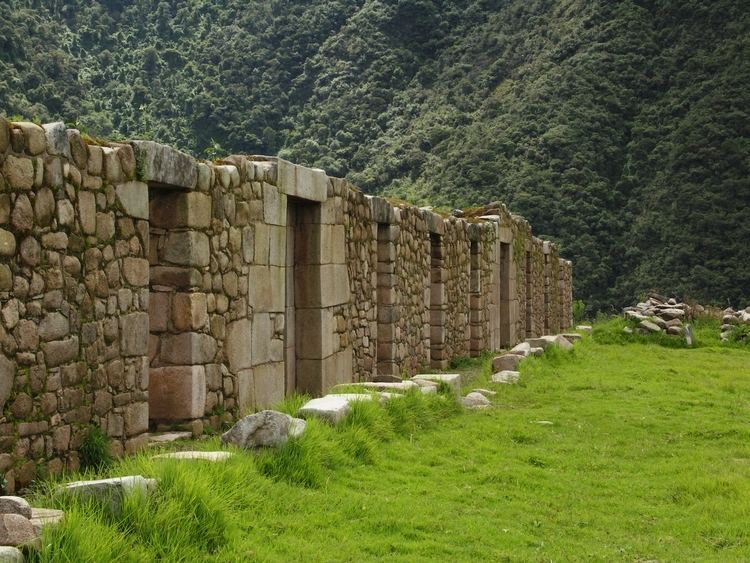 | ||
Vilcabamba (in hispanicized spelling), Willkapampa (Aymara and Quechua) or Espíritu Pampa was a city founded by Manco Inca in 1539 and was the capital of the Neo-Inca State, the last refuge of the Inca Empire until it fell to the Spaniards in 1572, signaling the end of Inca resistance to Spanish rule. The city was then destroyed, rediscovered in 1911, and scholars believe it to be the fabled "Lost city of the Incas".
Contents
- Map of Vilcabamba District Peru
- History
- Inca remnant
- Spanish Vilcabamba
- Archaeologic studies
- In popular culture
- References
Map of Vilcabamba District, Peru
It is located on the Chontabamba River, a tributary of the Urubamba River. It is often referred to as Vilcabamba the Old or Old Vilcabamba to distinguish it from the Spanish colonial town of Vilcabamba la Nueva.
History
Manco Inca retreated from Ollantaytambo to Vitcos, and finally to Vilcabamba: "The Inca brought together all those of the royal blood he could find, men and women alike, and retired to the wild forest of the Antis to a place called Villcapampa where he lived in exile and solitude as one can imagine a dispossessed and disinherited prince would live, until one day he was slain by a Spaniard whom he had sheltered and protected from enemies who had sought his death."
Titu Cusi said this of his father Manco Inca Yupanqui, "Having arrived, he rested and recovered for a few days and built his houses and lodgings in order to settle down there, for it seemed to him like a good site for his capital seat."
Inca remnant
(to be expanded)
After the Neo-Inca State fell in 1572, the city was burned and the area swiftly became a remote, secluded spot.
Spanish Vilcabamba
San Francisco de la Vitoria de Vilcabamba, also known as Vilcabamba la Nueva ("the New"), was a Spanish colonial silver-mining town. It is located west of Vilcabamba the Old on the Vilcabamba River, a tributary of the Urubamba River.
Archaeologic studies
The location of Vilcabamba was forgotten.
The first outsiders in modern times to rediscover the remote forest site that has since come to be identified with Old Vilcabamba (Vilcabamba la Vieja) were three Cuzqueños: Manuel Ugarte, Manuel López Torres, and Juan Cancio Saavedra, in 1892. In 1911, Hiram Bingham with his book Lost City of the Incas brought to public attention the site of the ruins of the city at the remote forest site then called Espíritu Pampa, 130 kilometres (81 mi) west of Cuzco. Bingham, however, did not realize its significance and believed that Machu Picchu was the fabled "Vilcabamba", lost city and last refuge of the Incas.
In the 1960s, the explorations and discoveries of Antonio Santander Casselli and Gene Savoy finally associated the Espíritu Pampa site with the legendary Vilcabamba. Their 1970 book Antisuyo brought the site to even wider attention. Researcher and author John Hemming provided additional substantive confirmation as to Espíritu Pampa's significance in his 1970 The Conquest of the Incas.
In 1976, Professor Edmundo Guillén and Polish explorers Tony Halik and Elżbieta Dzikowska continued to explore the long-known ruins. However, before the expedition, Guillen visited a museum in Seville where he discovered letters from Spaniards, in which they described the progress of the invasion and what they found in Vilcabamba. Comparison between the letters' contents and the ruins provided additional proof of the location of Vilcabamba.
In 1981, the party of American explorer Gregory Deyermenjian reached and photographed parts of the site, soon thereafter generating a popular article concerning the site and its history.
Later extensive archeological work by Vincent Lee, and especially his exhaustive study, his 2000 book Forgotten Vilcabamba, gave further and even more precise confirmation that has made Espíritu Pampa the definitively accepted site of the historical Vilcabamba.
On 16 June 2006, a museum in Cuzco unveiled a plaque that commemorates the thirtieth anniversary of the 1976 Vilcabamba findings.
In popular culture
The lost city of Vilcabamba features in the educational computer game series The Amazon Trail, the Tomb Raider videogame and its remake Tomb Raider: Anniversary, and the books Evil Star and Necropolis by British thriller author Anthony Horowitz. Vilcabamba is also a playable place in the PlayStation 2 RPG Shadow Hearts: From the New World.
The second episode of Michael Wood's 2000 documentary series Conquistadors visits the site of Vilcabamba while telling the story of the fall of the Inca and retreat of Manco and his followers to the remote region as the last surviving remnant of the empire.
The city was the location of British writer Colin Thubron's 2002 novel, To the Last City, which was short-listed for the Man Booker Prize, and tells the story of a group of people who set off to explore the ruins of the Inca city in what has been described as a "Heart of Darkness narrative" in a "Marquezian setting".
The science fiction story "Vilcamba" (2010) by Harry Turtledove, which can be read on-line here, is a self-referential allegory of Vilcabamba as an alien invasion story set in the 22nd century.
